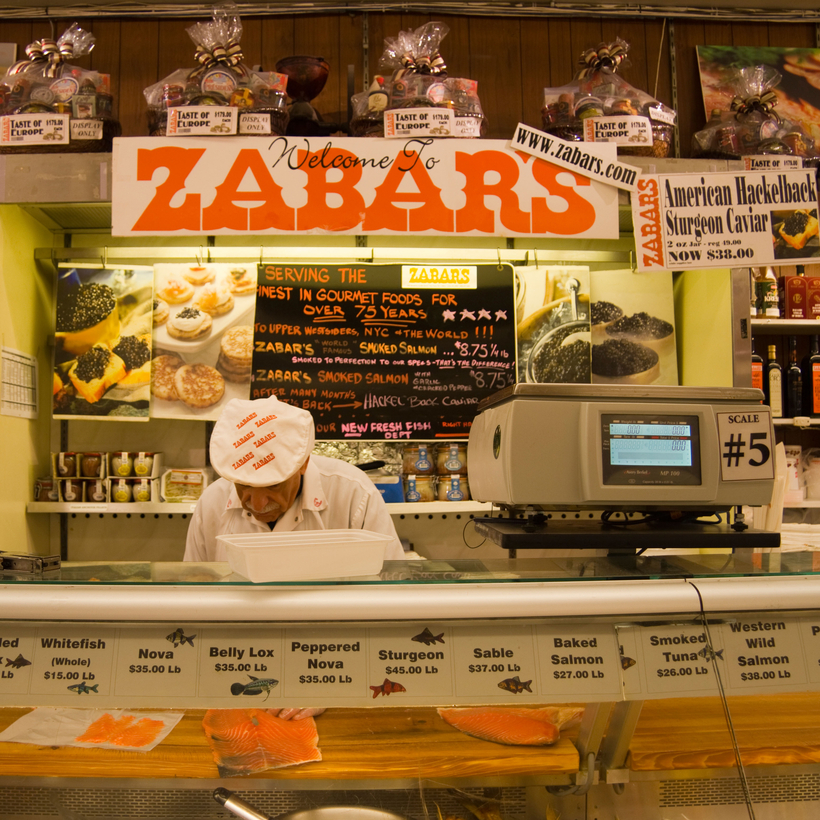It is difficult to explain to nonbelievers why so many worship at the food temple called Zabar’s. True, the store has a great backstory: a young immigrant grocer named Louis Zabar developed a painful rash handling fruit and vegetable skins, an affliction relieved only by sticking his hands and arms into a barrel of pickled herring and its soothing brine. Thus, the need to branch out into less allergic products combined with an attractive lease in a building on New York’s Upper West Side led Louis and his wife, Lilly, to open Zabar’s in 1934.
The Zabars had three sons, Saul, Eli, and Stanley, all three still alive and two of them still running the business. (Eli started his own food empire on the East Side of Manhattan and, contrary to myth, remains close to his brothers.) Lori Zabar, one of Stanley’s three children, has written a loving and yet surprisingly candid history of the store and the family, complete with recipes for store favorites such as Lilly Zabar’s sweet noodle kugel, flanken soup, and, of course, chopped liver.

These dishes, as delicious as they may be, do not explain the longevity of a store in a city that nearly leveled Carnegie Hall in the 1950s, tore down the old Penn Station in the 1960s, and eats and spits out mom-and-pop shops like pistachio shells. If the Harvard Business School ever did a case study of why Zabar’s is more successful today than it has ever been, the key powerpoints would include:
1) START A PRICE WAR: In 1973, when a French company introduced an instantly popular kitchen appliance called Cuisinart, Murray Klein, the third business partner of Saul and Stanley, slashed the retail price of the food processor to just a few dollars over wholesale ($135 instead of the $190 charged by Macy’s) and trumpeted the news. Even a lawsuit by Cuisinart’s distributor could not deter Klein, who also began throwing in a free coffee grinder and five pounds of beans. So great was the publicity that Zabar’s moved the battle to other fronts, such as caviar and Lindt chocolate bars.

2) FIND A LOSS LEADER: Smoked salmon is where Zabar’s fame lies, and its slicing counter, with its skilled surgeons and long lines, is the store’s beating heart. But for many years the store did not make a penny on its best-known product, so as to lure customers to pass through its doors.
3) KEEP QUALITY HIGH AND PRICES LOW: Ms. Zabar details just how much work goes into selecting the fish, roasting the beans, sugar-curing the herring—and who wouldn’t want the job of caviar taster? (No coffee, onions, or lemons for you on your tasting day. Such sacrifice!) As for quantity, I counted 41 olive varieties the last time I visited, and I skipped a cheese census lest I myself grow mold. And as for low prices, see powerpoint No. 2.

4) BUY YOUR BUILDING, AND WHILE YOU’RE AT IT, BUY A LOT OF BUILDINGS AROUND YOU: Zabar’s will never be priced out of its own lease, the stroke that kills so many other family businesses, and as high-rises grow up around them, one can only imagine how much money the family makes just by selling air rights. No wonder lox was once sold at cost.
5) TREAT EMPLOYEES LIKE FAMILY: The easiest way to do this is to hire as many family members as possible, and Ms. Zabar is at her proudest when she ticks off all the relatives who work there, many of them pitching in just for the holidays. Her brother David is the executive director and, along with her cousin Aaron, will lead the store into the future, once Saul, now 93, and Stanley, 89, retire. They treat their nonfamily members well, with profit sharing for some, promoting cashiers to managers, and helping with medical bills. One employee was so loyal that as his dying wish he asked that his ashes find a home there, which is why today they reside in the soil of a potted plant on the windowsill of a second-floor conference room facing Broadway.

Indeed, the real secret of the store’s success is that the Zabars treat their customers as family, and their customers in turn feel a kinship with each other. Spot a stranger on the street with the distinctive orange-and-white shopping bag, and you can make enough assumptions about that person to know you are a member of the same tribe, the same clan that likes to read the paper edition of the Sunday New York Times and attend the Metropolitan Opera.
This is a joyful book, made poignant when you learn that Lori Zabar died a few months before its publication. She was 67, and had lived with cancer for several years while she finished her book. One way to honor her memory is to try your hand at making that sweet noodle kugel.

Jim Kelly is the Books Editor for AIR MAIL

